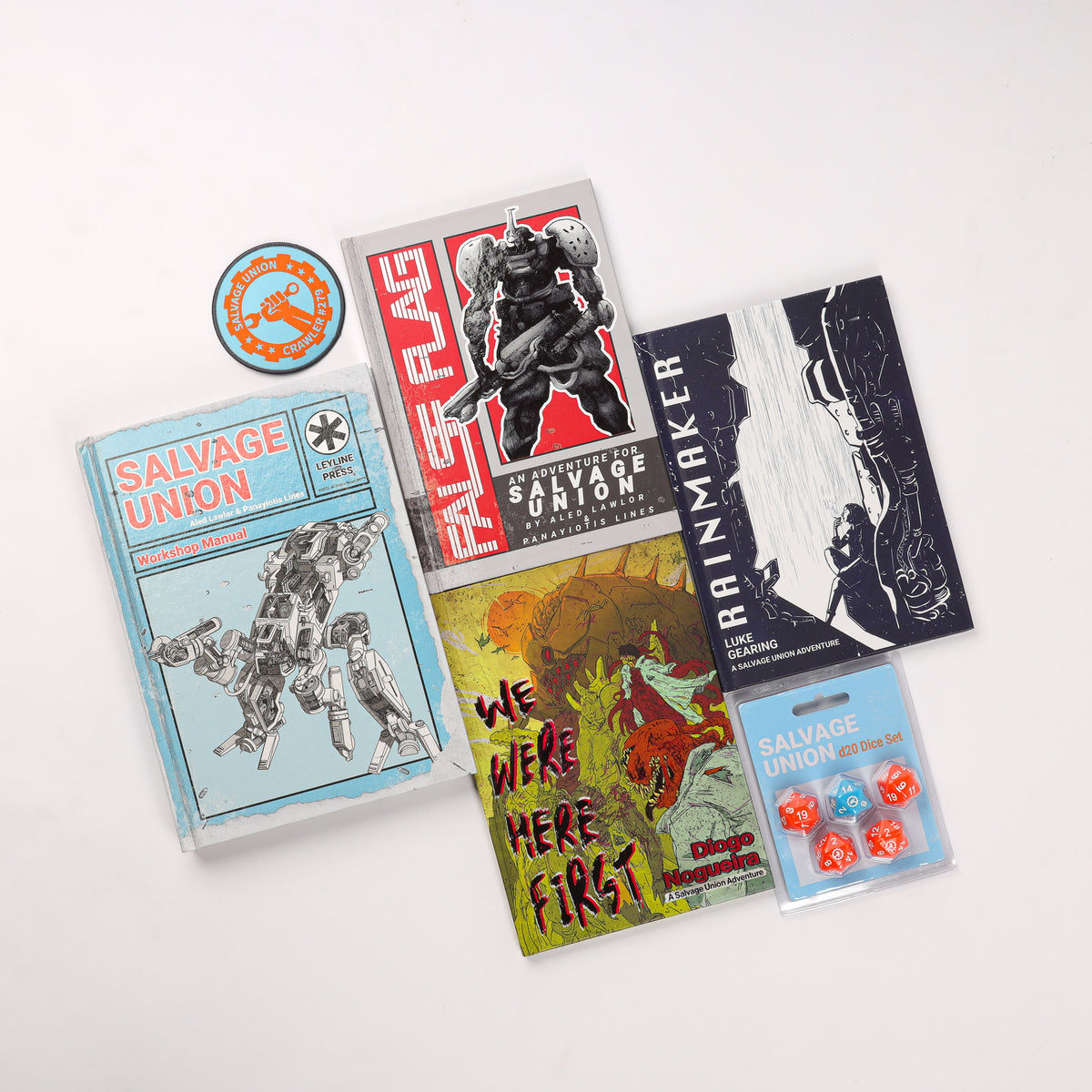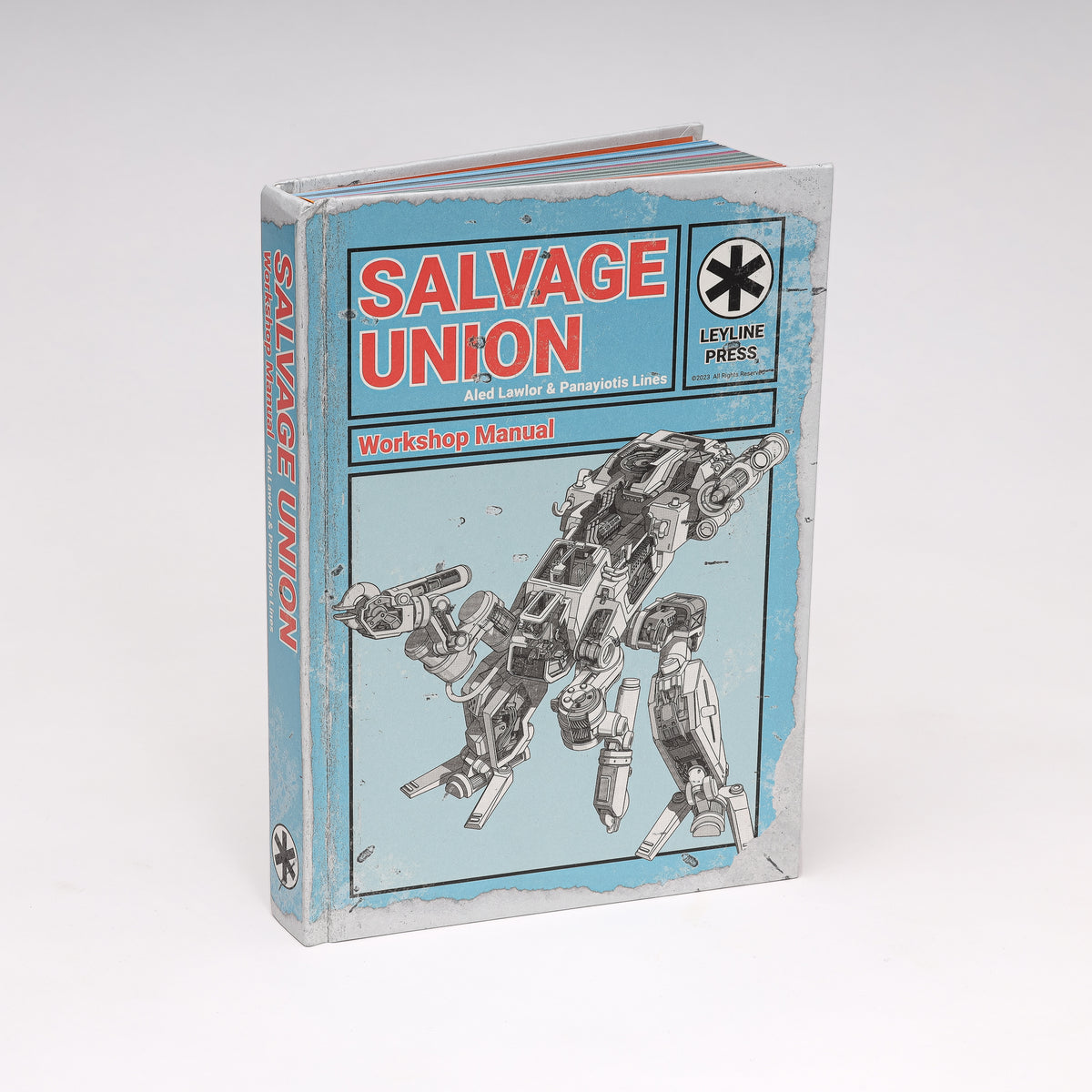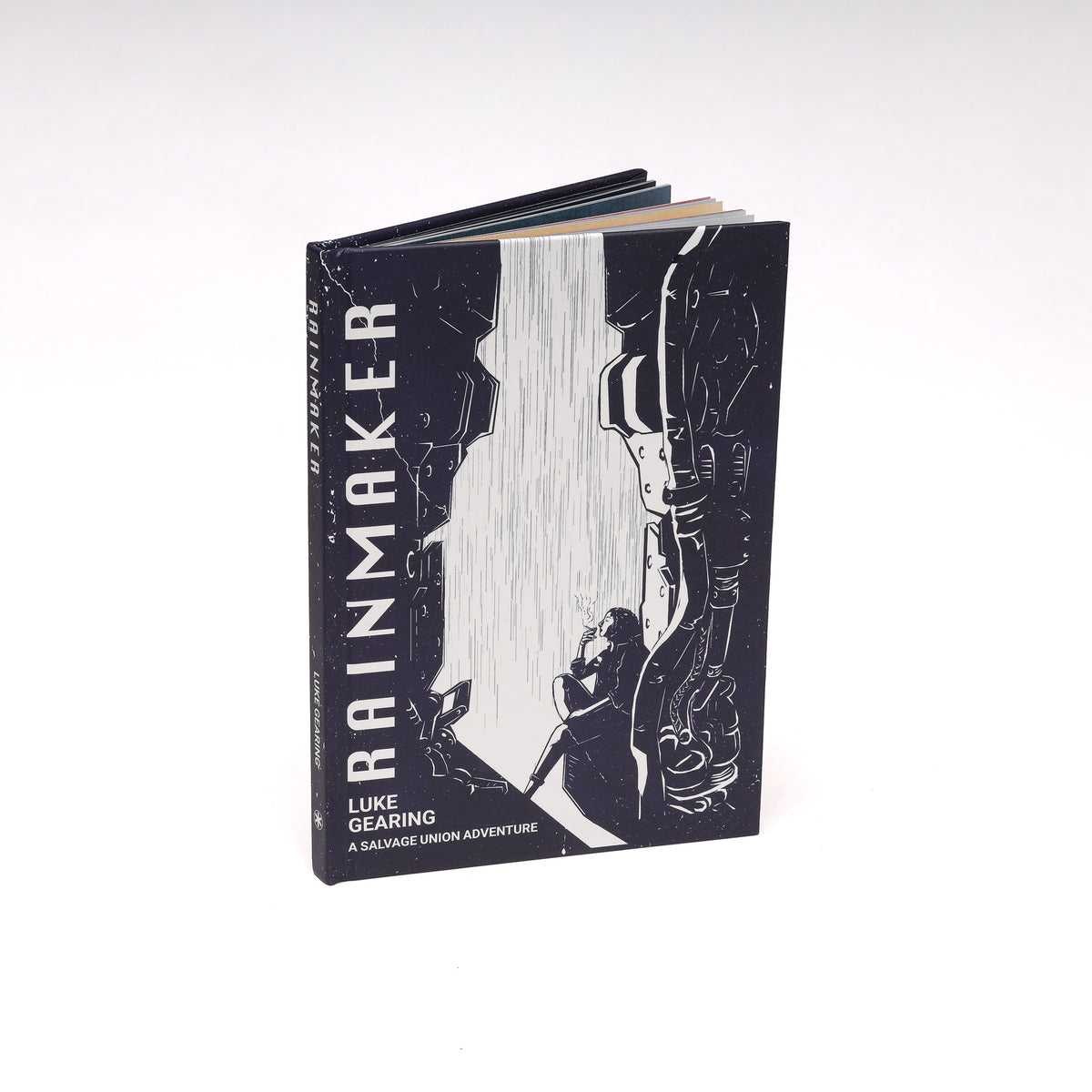Our core design goal with Salvage Union was to create a simple-to-learn mech tabletop role-playing game, which retained the essence of the genre while vastly simplifying its mechanics and learning curve. One key aspect that makes mech games appealing is the ability to customise your own unique mech, fine-tuning its various options to your tastes. In Salvage Union, we wanted to intertwine this customisation with the role of salvagers scouring the wasteland for scrap. This blog explores the challenges myself, Panayiotis Lines @panny_lines, and Aled Lawlor,@aledlawlor, encountered in developing a salvaging and crafting system for Salvage Union that met these design goals.

In Salvage Union, Mechs are built using a Chassis as the core, Systems as external hardware (such as weapons or rigging arms), and Modules as internal parts (like comms or coolant devices). Progression in the game revolves around finding scrap in the wastelands and using it to craft these various components.
Salvaging System Version 1:

The initial salvaging and crafting system required players to craft specific Systems and Modules from parts they found in play, based on crafting recipes we called 'blueprints.' For example, to craft a 30mm Autocannon System, you needed to use scrap metals, wiring loom, and a simple mechanism. These parts could also be obtained by breaking down the 30mm Autocannon and other items found in the game world, with some parts being rarer to find than others and needed to build more powerful things. This version can be found in the 1.0 Salvage Union Quickstart.

However, as the game expanded to include over 150 Systems and Modules, and 30 Mech Chassis, across six tech levels of play, inventory management became difficult. Encumbrance is often ignored in tabletop roleplaying games, we felt it was important to include in Salvage Union due to the core aesthetic of playing as salvagers hauling scrap across the wastelands. We however wanted to make it as simple as possible for players to engage with. The initial crafting system would work in video game that tracks all of the information for you, but in tabletop someone has to physically do the labour. As a result, tracking the vast number of parts and recipes on both an individual and group basis proved to be a significant challenge for players during playtests.

It further became apparent that this system required players to have a deep understanding of the different components and their blueprints. This complexity hindered accessibility for new players, as it demanded prior knowledge of the game's systems, modules, and chassis. This created an expectation of system mastery that we wanted to avoid in a game designed to be approachable and beginner-friendly.
The initial crafting system also significantly slowed down the game due to the time-consuming decision-making process during salvaging. We wanted to streamline this aspect of the game to align with the dynamic and fast-paced experience we wanted from play.
Salvaging System Version 2:

To address the challenges we encountered, we introduced a revised crafting system, which can be found in the 1.5 version of the Salvage Union Quickstart. In this iteration, we eliminated individual parts and replaced them with a generic unit called "Scrap," differentiated by Tech Levels. We further introduced a number known as Salvage Value, which played a crucial role in simplifying the system and resolving inventory management issues.
The Salvage Value denoted the following for every chassis, system, and module:
- How much Scrap of its Tech Level you received when you salvaged it.
- How much Scrap of its Tech Level it cost to craft it.
- How much Scrap of its Tech Level it cost to repair it if damaged.
- How many slots of your Mech's cargo capacity it took up.
Instead of requiring various individual parts to build a 30mm Autocannon, you now needed an amount of scrap based on its Salvage Value. Similarly, salvaging a 30mm Autocannon would provide scrap based on the same value. Scrap's Tech Level determined its value, with higher Tech Level scrap being required to build more advanced chassis, systems, and modules. Scrap was also interchangeable on a 1-1 basis during downtime or at trade hubs. For example, one Tech 3 Scrap traded for three Tech 1 Scrap.

This streamlined approach allowed players to quickly understand the relative value of scrap and what they could do with it. Higher tech scrap became subtly more valuable because it occupied fewer cargo slots, providing an incentive to find higher tech levels of scrap to break down and return to the Union Crawler for crafting during downtime.
Within this variant we included additional calculations based on the Salvage Value, for example crafting something cost 2x its salvage value, repairing it cost its Salvage Value in scrap. Salvaging a damaged part meant you only received half of its Salvage Value in scrap. These calculations proved challenging to remember during gameplay. It also felt punishing for players, as the way the numbers broke down didn't give them enough scrap to actually build new parts, instead, they often spent most of it on repairs which is not what we wanted.
Blueprint System:
As part of this iteration of the crafting system, we introduced a Blueprint system to determine what players could craft with the scrap they found.
Players could destroy obtained Systems, Modules, or Chassis to reverse engineer their blueprints. This allowed the entire group to craft those items for the rest of the campaign, at the cost of not being able to immediately salvage them. Blueprints could also be researched during downtime or discovered through abilities and rewards.

While the blueprint system added depth, it also introduced complexity and decision points, which often slowed down gameplay. Tracking numerous blueprints also required players to have an extensive list of 200 different blueprints from the Salvage Union Core Book alone. This would have had to have been updated with additional content from the Salvage Union Adventure Modules and potential additional content planned for future releases. Furthermore, the system constrained player agency, as The Mediator controlled access to blueprints, contradicting the sandbox play experience we intended.
Salvaging System Version 3:

In Version 3 of the system, we made significant simplifications to the Salvage Value calculations, added more ways to repair, and removed the blueprint system entirely.
Instead of blueprints, players could now craft anything that was of the Tech Level of their Union Crawler. If they were at Tech 2, then they could craft any Tech 1 or 2 Chassis, Systems, or Modules, and it was assumed they had access to all of them within the core book.

Crafting a System, Module, or Chassis now only required spending its Salvage Value in scrap of the corresponding Tech Level. Repairing damaged parts required spending half of their Salvage Value in scrap. When salvaging a system, module, or chassis, players would receive an amount of scrap equal to its Salvage Value, regardless of its condition. This simplified approach made it easier to remember and encouraged players to repair damaged parts, allowing for more customisation options and experimentation.
Version 3 also introduced additional Systems, Pilot Equipment, and abilities that allowed players to repair damaged Chassis, Systems, and Modules. This meant less scrap repairing and more spent crafting. It also enabled players to more easily repair and immediately use damaged parts they found in play.

Mechs were now entirely repaired during downtime as long as they were of the same Tech Level as the player's Union Crawler. This change provided more flexibility and customisation opportunities while adding a risk-reward decision of using higher and more powerful Tech Level parts at the risk of a higher repair cost.
The streamlined salvage and crafting system in Salvage Union achieved the desired simplicity in gameplay while still offering a wide range of customisation options for players. You can find this final version of the system in the Salvage Union Core Book PDF.
Additional Notes:
Game design is a messy process, and the outlined versions of the game provided a simplified overview. There were additional considerations and iterations within the system, such as changes to building mech chassis. Although not included in this article for simplicity's sake, we may explore these aspects in future blogs.
The blueprint system does remain in a small vestige in the Spectrum Mechs scanning ability and some Mediator advice to encourage those running Salvage Union to give blueprints out as rewards. We still liked blueprints and wanted to explore it in a small and manageable way in play but realized we couldn't tie it to the core of the game.
We, at one stage, had a crafting system for Pilot Equipment. However, we felt this was far too complicated on top of Mech crafting, so we removed it entirely, replacing it with a much simpler method of distributing such equipment.

Interested in playing Salvage Union?
Salvage Union is now available to buy here.
You can download the free QuickStart here https://leyline.press/products/salvage-union-beta-quickstart-digital-edition-pdf
You can join the Salvage Union Discord here where we're running weekly playtest games - https://discord.gg/gmM6jTT8qm
Follow Salvage Union on Twitter - @salvageunion
Follow Salvage Union on Instagram - @salvageunionrpg
Subscribe to the Leyline Press newsletter here to receive updates Salvage Union and our other games.






0 comments